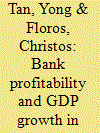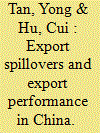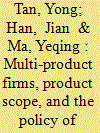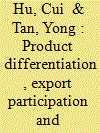|
|
|
Sort Order |
|
|
|
Items / Page
|
|
|
|
|
|
|
| Srl | Item |
| 1 |
ID:
113688


|
|
|
|
|
| Publication |
2012.
|
| Summary/Abstract |
This article examines the effect of GDP growth on bank profitability in China over the period 2003-2009. The one-step system GMM estimator is used to test the persistence of profitability in the Chinese banking industry. The empirical findings suggest that cost efficiency is positively related to bank profitability, while lower profitability can also be explained by higher taxes paid by banks. In addition, there is a negative relationship between GDP growth and bank profitability. Furthermore, the results show that (1) the profitability in the Chinese banking industry is significantly affected by the level of non-performing loans, and (2) Chinese banks with higher levels of capital have lower profitability. Finally, we find that the departure from a perfectly competitive market structure in the Chinese banking industry is relatively small.
|
|
|
|
|
|
|
|
|
|
|
|
|
|
|
|
| 2 |
ID:
149762


|
|
|
|
|
| Summary/Abstract |
This paper examines the local export spillover effect on the individual decisions to start exporting (the extensive margin) and export volume (the intensive margin), using a unique dataset of Chinese export firms, at the product-level and by destination country. Based on a gravity-type equation estimated at firm-level, we find that export spillovers positively influence not only the decision of a nearby firm to start exporting, but also the volume of the exporting. Several methods are used to verify the robustness of these results. In addition, we find that the effect of export spillovers is stronger when it is product-destination-specific than that when it is either product or destination-specific alone, and also stronger than that is in general. Geographically, local export spillovers exhibit spatial decay in China: the effect is stronger for firms located in the same city than it is for firms outside the city. Small and multi-product firms are more likely to be influenced by the local export spillovers, and their impact is stronger for firms exporting complex goods and exporting to easy-entry countries. Moreover, the export spillovers from private firms are the strongest, followed by foreign-invested firms with the effect generated by state-owned firms ranking last.
|
|
|
|
|
|
|
|
|
|
|
|
|
|
|
|
| 3 |
ID:
143387


|
|
|
|
|
| Summary/Abstract |
This paper extends the model of Nocke and Yeaple (2014) to analyze the impact of the export tax rebate (ETR) changes on multi-product firms' product scope. In response to ETR changes, firms optimally reallocate their organizational capital, and adjust the intensive and extensive margins of production. We test the model's predictions using firm-level export and ETR data from China. We find that less profitable products, facing larger ETR reductions, and products in which China has a comparative disadvantage, are more likely to be dropped.
|
|
|
|
|
|
|
|
|
|
|
|
|
|
|
|
| 4 |
ID:
149772


|
|
|
|
|
| Summary/Abstract |
In this paper, we investigate how the degree of export participation and product differentiation affect firms' productivity growth through learning-by-exporting. We extend the model of Melitz and Ottaviano (2008) to endogenize the effort firms allocate to learning. This effort choice depends on both the degree to which firms enter export markets and the extent to which products are differentiated across producers. Using a firm-level dataset from China's manufacturing industries, we implement propensity score matching methods to test the model's predictions. Our results indicate that the degree of export participation is positively correlated with TFP improvements. Simultaneously, we empirically verify that firms exporting less differentiated products experience faster TFP growth than those exporting more differentiated products.
|
|
|
|
|
|
|
|
|
|
|
|
|
|
|
|
|
|
|
|
|